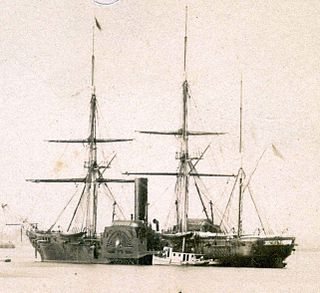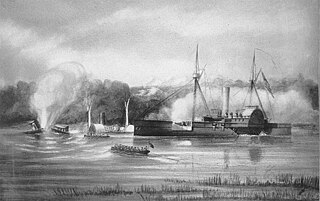
CSSEllis (later USSEllis) was a gunboat in the Confederate States Navy and the United States Navy during the American Civil War. It was lost during a raid while under command of famed Navy officer Lieutenant William B. Cushing.

CSSEllis (later USSEllis) was a gunboat in the Confederate States Navy and the United States Navy during the American Civil War. It was lost during a raid while under command of famed Navy officer Lieutenant William B. Cushing.
The Ellis was purchased at Norfolk, Virginia in 1861 by the State of North Carolina and turned over to the Confederacy when that State became a member. With Commander W. T. Muse, CSN, in command, she played an important part in the defense of Fort Hatteras and Fort Clark in Hatteras Inlet, North Carolina on August 28–29, 1861, of Roanoke Island on February 7–8, 1862, and of Elizabeth City, North Carolina on February 10, 1862; that day she was captured by the Union Army after a desperate struggle in which her commander, Lieutenant James W. Cooke, CSN, was badly wounded.
Ellis was taken into the U.S. Navy and assigned to the North Atlantic Blockading Squadron. She was placed under the command of Lieutenant C. L. Franklin, USN, and spent her entire U.S. Navy service in the sounds and rivers of North Carolina.
Ellis took part in a combined expedition which captured Fort Macon, near Beaufort, North Carolina, on April 25, 1862. She had a brief engagement with Confederate cavalry off Winton, North Carolina on June 27, 1862, and from August 15 to 19, 1862, she made an expedition to Swansboro, North Carolina, to destroy salt works and a battery. On October 14, 1862, she was detailed to the blockade of Bogue Inlet, and a week later, captured and burned the schooner Adelaide with a valuable cargo of turpentine, cotton, and tobacco.
In November 1862, Ellis, under command of Lieutenant William B. Cushing, sailed up New River Inlet to capture Jacksonville, North Carolina. The steamer captured two schooners, some arms and mail. On her way down river, Ellis ran aground on November 24, 1862, and could not be re-floated. After dark, her commanding officer moved all the crew except six and all her equipment and supplies except her pivot gun, some ammunition, two tons of coal, and a few small arms to one of the captured schooners. While the schooners slipped down the river to wait, Cushing and five of his men remained to fight it out. Early on the morning of November 25, 1862, the Confederates opened fire on Ellis, and in a short time, Cushing was forced to decide between surrender and a pull of a mile and a half to a waiting schooner. Cushing chose not to surrender, and before leaving his ship, set fire to her in five places, leaving the gun trained on the enemy to let the ship herself carry on the fight when flames would fire the cannon. Cushing and his men reached the schooner and made for the sea, getting the vessel over the bar just in time to escape several companies of cavalry trying to cut off the schooner at the mouth of the inlet. Ellis was blown to pieces by the explosion of her magazine on the morning of November 25, 1862.

CSS Robert E. Lee was a fast paddle-steamer, originally built as a Glasgow-Belfast packet boat named Giraffe, which was bought as a blockade runner for the Confederate States during the American Civil War, then subsequently served in the United States Navy as USS Fort Donelson and in the Chilean Navy as Concepción.

USS Susquehanna, a sidewheel steam frigate, was the first ship of the United States Navy to be named for the Susquehanna River, which rises in Lake Otsego in central New York and flows across Pennsylvania and the northeast corner of Maryland emptying into the Chesapeake Bay.

The third USS Water Witch was a wooden-hulled, sidewheel gunboat in the United States Navy during the American Civil War. She is best known as the ship fired on by Paraguay in 1855. In 1864 she was captured by the Confederate States Navy, and subsequently was taken into that Navy as CSS Water Witch.

Harriet Lane was a revenue cutter of the United States Revenue Cutter Service and, on the outbreak of the American Civil War, a ship of the United States Navy and later Confederate States Navy. The craft was named after the niece of senator and later United States President, James Buchanan; during his presidency, she acted as First Lady. The cutter was christened and entered the water for the Revenue Service in 1859 out of New York City, and saw action during the Civil War at Fort Sumter, New Orleans, Galveston, Texas, and Virginia Point. The Confederates captured her in 1863, whereupon she was converted to mercantile service. Union forces recaptured her at the end of war. The U.S. Navy declared her unfit for service and sold her. New owners out of Philadelphia renamed her Elliot Ritchie. Her crew abandoned her at sea in 1881.

USS Stars and Stripes was a 407-ton steamer acquired by the U.S. Navy and put to use by the Union during the American Civil War.

The first USS Monticello was a wooden screw-steamer in the Union Navy during the American Civil War. She was named for the home of Thomas Jefferson. She was briefly named Star in May 1861.

The second USS Louisiana was a propeller-driven iron-hull steamer in the United States Navy during the American Civil War.

USS Wyalusing was a double-ended, side-wheel gunboat that served in the United States Navy during the American Civil War. She was named for the borough of Wyalusing in Bradford County, Pennsylvania.

USS Albatross was a screw steamer rigged as a three-masted schooner acquired by the Union Navy during the beginning of the American Civil War. She was outfitted as a gunboat with heavy guns and used in the Union blockade of the waterways of the Confederate States of America.

USS Valley City was a 190-ton steamer acquired by the Union Navy for service in the American Civil War.

USS Underwriter was a 341-ton sidewheel steamer that was purchased for military use by the Union Navy during the American Civil War.
USS Shawsheen was a steam operated tugboat acquired by the Union Navy during the American Civil War.

USS Hetzel was a steamer acquired by the Union Navy during the American Civil War. She was used by the Navy to patrol navigable waterways of the Confederacy to prevent the South from trading with other countries.

USS Calhoun was a captured Confederate steamer and blockade runner acquired by the Union Navy from the prize court during the American Civil War.

CSS Fanny was a small propeller-driven steam tug used by the Confederate States Navy to defend the sounds of northeastern North Carolina in the American Civil War. Originally armed as a gunboat and operated by the Union, she was captured in October 1861 by the Confederate Navy, and later lost at the Battle of Elizabeth City in February 1862. Due to being used as an observation balloon platform, Fanny is sometimes credited with being the first self-propelled aircraft carrier.
USS Britannia was a steamer captured by the Union Navy during the American Civil War. She was used by the Union Navy as a gunboat and patrol vessel in support of the Union Navy blockade of Confederate waterways.
USS Henry Brinker was a small steamship acquired by the Union Navy during the American Civil War. She was placed into service as a gunboat and assigned to the blockade of ports of the Confederate States of America.
The third USS Union was a heavy (1,114-ton) steamer with a powerful 12-inch rifled gun purchased by the United States Navy during the American Civil War.

John Cummings Howell was an officer in the United States Navy during the American Civil War. He rose to the rank of rear admiral and late in his career was commander-in-chief of the North Atlantic Squadron and then of the European Squadron.
CSS Winslow was a sidewheel steamer that was used as a gunboat in the early stages of the American Civil War. Launched in 1846 as Joseph E. Coffee or J. E. Coffee, the vessel was used in the coastal merchant trade. In 1861, she was purchased at Norfolk, Virginia, and was equipped as a military vessel by the state government of North Carolina. Known as Winslow or Warren Winslow in military service, the vessel took part in commerce raiding against Union shipping, capturing 16 vessels from May to August 1861. In July, she was transferred from serving for the state of North Carolina to the Confederate States Navy. During the Battle of Forts Hatteras and Clark on August 28, Winslow landed reinforcements for Confederate-held Fort Hatteras, and then evacuated survivors the next day, with the Union gaining control of the position. As part of an operation to rescue the crew of the wrecked French corvette Prony, Winslow struck the wreck of a lightship on November 7. The Confederates rescued Winslow's crew and burned the wreck.